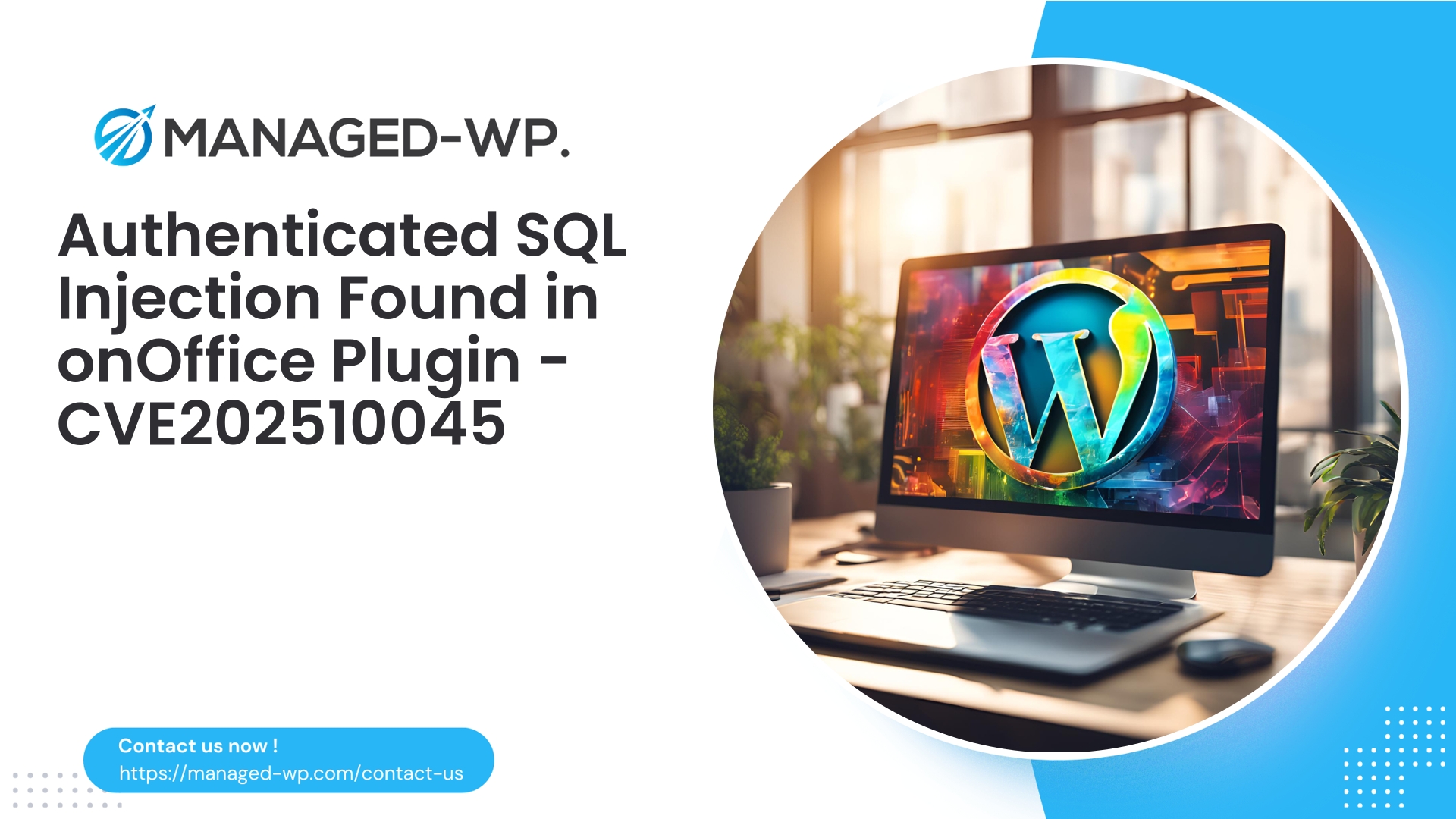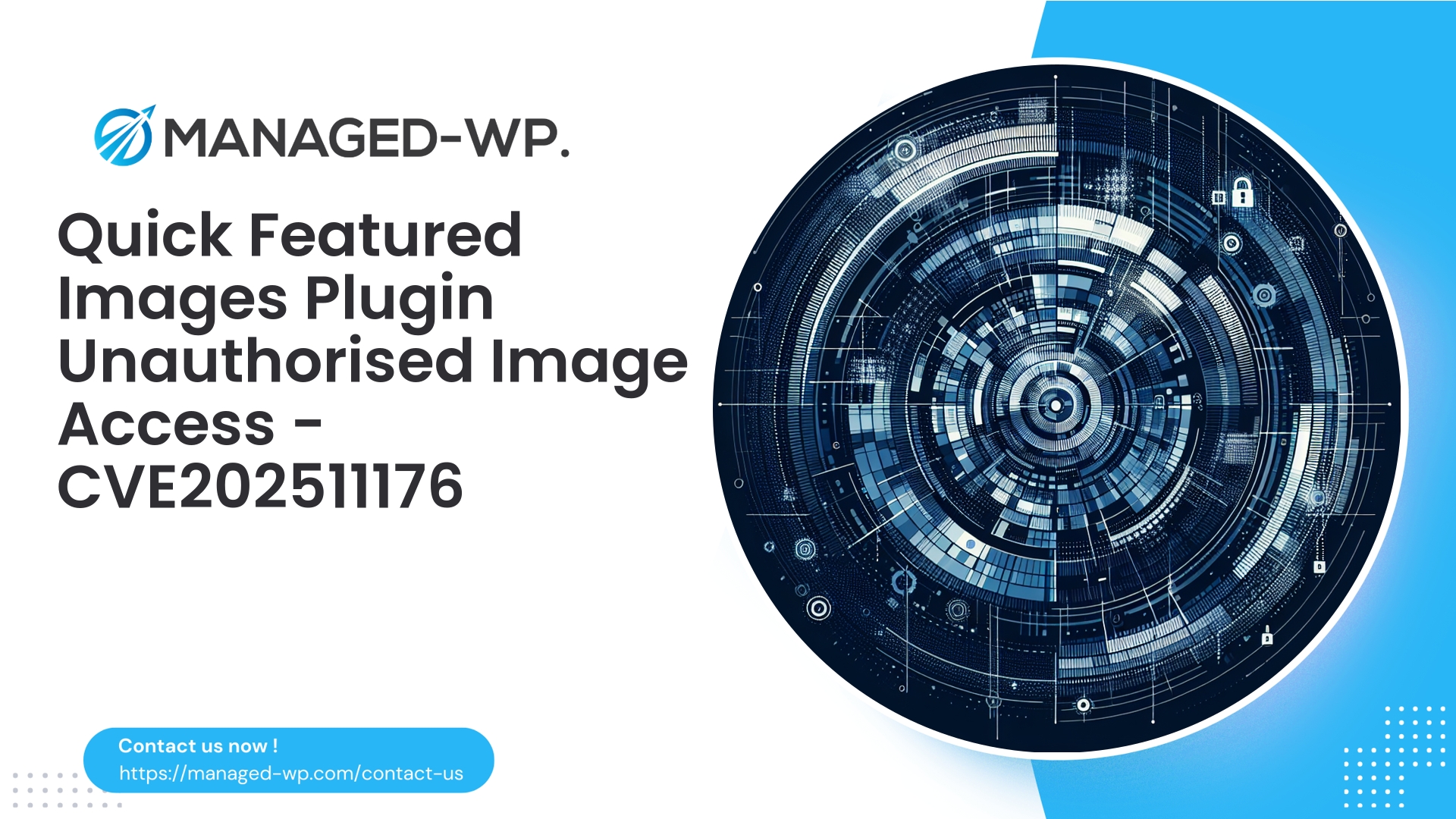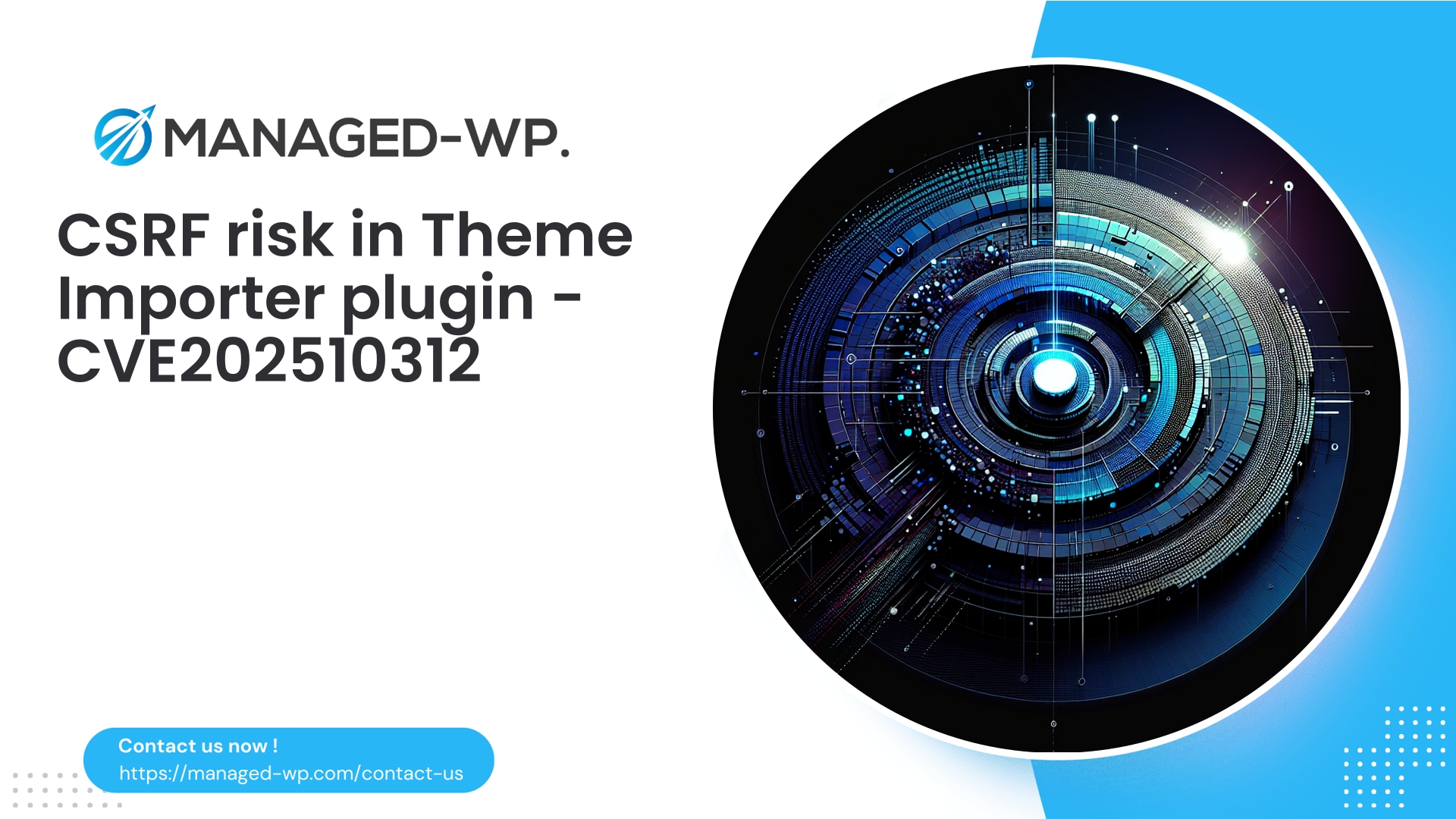| 插件名稱 | onOffice for WP-Websites |
|---|---|
| 漏洞類型 | SQL注入 |
| CVE編號 | CVE-2025-10045 |
| 緊急 | 低的 |
| CVE 發布日期 | 2025-10-15 |
| 來源網址 | CVE-2025-10045 |
針對 WordPress 網站 (≤ 5.7) 的 onOffice 外掛程式中已認證(編輯+)使用者的 SQL 注入漏洞:WordPress 網站所有者必須採取的關鍵措施
2025年10月15日,onOffice for WP-Websites WordPress外掛的一個涉及SQL注入的安全漏洞被公開揭露,該漏洞影響到5.7及更早版本。該漏洞被識別為: CVE-2025-10045攻擊者需要擁有經過身份驗證的編輯等級或更高等級的存取權限才能利用此漏洞。儘管緊急程度較低,但由於此漏洞直接針對 WordPress 資料庫,且其 CVSS 評分高達 7.6 分(類似於安全漏洞評估工具),因此仍構成重大風險,可能造成嚴重後果。
作為專注於 WordPress 安全防護的美國安全專家,Managed-WP 對該漏洞進行了專業且務實的評估。本簡報概述了技術細節、風險評估以及網站所有者可以採取的切實有效的防禦措施,以保護其平台。雖然在漏洞披露時官方尚未發布補丁,但 Managed-WP 的託管式 Web 應用程式防火牆 (WAF) 服務能夠提供至關重要的保護,以彌補這一安全漏洞。
重要的: 如果您的網站運行的是 Office for WP-Websites 外掛程式 5.7 或更早版本,則必須立即採取措施來降低風險。
執行摘要
- 漏洞: onOffice for WP-Websites 外掛程式(≤ 5.7)中存在已驗證的 SQL 注入漏洞。 CVE-2025-10045。
- 需要權限: 在 WordPress 網站上擁有編輯或更高權限。
- 影響: 未經授權的資料庫存取可能導致資料外洩、使用者和內容操縱,以及根據資料庫權限透過精心建構的有效載荷進行潛在的程式碼注入。
- 官方補丁: 截至撰寫本文時,該產品仍無法提供,因此需要採取預防措施。
- 立即採取緩解措施: 停用或移除插件,限制編輯器帳戶,輪換憑證,強制執行多因素身份驗證,透過 WAF 應用虛擬補丁,密切監控日誌。
- 推薦防護措施: 部署 Managed-WP 的 WAF,進行虛擬修補,執行有針對性的安全審查,並在應用補救措施之前維護最新的備份。
了解漏洞
SQL注入(SQLi)是一種漏洞,攻擊者可以利用它向應用程式執行的資料庫查詢中註入惡意SQL命令。這種漏洞會損害資料的機密性和完整性,在極少數情況下,甚至會導致遠端程式碼執行。
此漏洞被歸類為「已認證 SQL 注入」。攻擊者必須擁有 WordPress 編輯等級或更高等級的帳戶才能利用此漏洞。鑑於編輯角色通常屬於貢獻者、承包商或第三方合作者,因此其攻擊面比僅限管理員的漏洞更為廣泛。
此漏洞的產生是因為插件在建構 SQL 語句之前,對輸入參數的清理和綁定處理不當。因此,擁有編輯權限的攻擊者可以提交精心建構的輸入,從而篡改底層資料庫上執行的查詢,進而洩漏或操縱超出預期範圍的資料。
為什麼編輯級存取權限至關重要
人們普遍誤以為只有管理員權限漏洞才會構成嚴重風險。但 WordPress 安全性的實際情況,正如本次漏洞所凸顯的,是編輯器層級的漏洞同樣危險:
- 編輯帳戶通常具有廣泛的內容管理功能,並且可以存取插件功能,從而擴大攻擊面。
- 攻擊者經常利用社會工程、網路釣魚或憑證重用來取得編輯憑證,而編輯憑證的安全性通常低於管理員帳戶。
- 這種等級的 SQL 注入可以列舉使用者、修改密碼、篡改網站內容,並為提升存取權限或植入後門提供跳板。
Managed-WP 強烈建議以與處理更高權限漏洞相同的緊迫性來處理編輯器層級的漏洞。
技術細節(非剝削性概述)
- 該外掛程式公開一個或多個可供編輯人員存取的管理端點(例如,透過 AJAX 或 REST 控制器)。
- 這些端點接受的輸入參數直接被納入 SQL 查詢中,而沒有進行適當的參數化。
- 攻擊者可以精心建構輸入,以規避預期的 SQL 語法上下文並執行任意 SQL 語句。
- 可能洩漏或篡改的資料包括使用者電子郵件、角色、貼文、外掛程式設定和其他敏感網站資料。
- 利用此漏洞進行資料操縱可以植入惡意內容或改變網站行為,從而導致進一步的攻擊。
值得注意的是,許多 WordPress 外掛預設信任編輯層級的用戶,這導致輸入驗證不足——此漏洞暴露了這一關鍵疏忽。
潛在影響和風險
成功利用漏洞可能導致:
- 竊取個人數據,例如用戶電子郵件和雜湊密碼。
- 未經授權建立或提升使用者帳戶權限。
- 修改或刪除頁面和貼文可能會損害您網站的聲譽。
- 透過惡意短代碼或內容欄位插入持久性後門。
- 利用洩漏的憑證在託管基礎設施或連接服務中進行橫向移動。
- 搜尋引擎會因注入垃圾郵件或重定向而對其進行處罰。
- 在某些主機配置中,存在透過鍊式攻擊執行遠端程式碼的風險。
您的網站面臨的風險很大程度上取決於授予 WordPress 的資料庫權限和外掛程式架構,但分配的漏洞評分錶明存在重大風險。
網站所有者應立即採取的措施
- 將您的網站置於維護模式或唯讀模式。 如果可行,應在評估期間防止主動利用漏洞。
- 停用 onOffice 插件 如果它對網站的即時功能並非至關重要:
- 導覽至外掛程式 → 已安裝外掛程式 → 停用 onOffice for WP-Websites。
- 如果您必須保持插件處於啟用狀態, 限制對其管理介面的訪問 透過 IP 或網路層級控制。
- 審核所有編輯和管理員帳戶:
- 停用或刪除不常用的帳號。
- 立即強制執行強密碼重設。
- 盡可能使會話和令牌失效。
- 輪換所有已儲存的憑證 如果偵測到,則在插件選項或瞬態資料中進行處理。
- 請確認您已測試過備份。 在進行進一步修改之前。
- 實作或更新 Web 應用程式防火牆 (WAF) 透過虛擬修補來阻止已知的攻擊途徑。
- 啟用多因素身份驗證 (MFA) 適用於所有編輯和管理員。
- 加強監測 — 文件完整性、稽核日誌和資料庫查詢日誌(如有)。
- 如果出現可疑活動,請隔離您的網站並啟動事件回應程式。
停用存在漏洞的插件是最直接的保護措施。如果操作上不可行,則應立即透過 Managed-WP 的 WAF 進行虛擬修補。
識別剝削跡象
- 編輯或管理員的登入出現異常或不尋常的情況,尤其是來自陌生 IP 位址的登入。
- 內容發生無法解釋的變更或刪除。
- 建立具有更高權限的新使用者帳戶。
- usermeta、wp_posts 或 wp_options 中的新增或修改的資料庫項目。
- 異常電子郵件活動,例如大量密碼重設或通知。
- Web 伺服器日誌顯示向 admin-ajax.php 或插件特定端點傳送的可疑 POST 請求包含 SQL 元字元。
- WAF 日誌發出有關 SQL 注入嘗試或異常查詢模式的警報。
任何已確認的攻擊都應立即觸發隔離、取證證據保存、憑證重置和專業事件回應。
安全檢測方法
- 仔細檢查訪問日誌,尋找針對插件端點的異常請求。
- 手動核查使用者帳戶,檢查是否有未經授權的新增或變更。
- 將目前資料庫轉儲與已知的乾淨版本進行比較,以發現意外差異。
- 檢查最近的文件更新是否有意外更改或篡改。
- 暫時啟用詳細的 WordPress 偵錯日誌,安全地捕捉異常情況。
警告: 做 不是 請勿嘗試自行利用該漏洞。未經授權的測試違反道德和法律規範。
緩解策略
短期(立即)
- 停用受影響的插件。
- 透過 IP 或網路過濾限制對外掛程式管理端點的存取。
- 強制重設密碼並減少編輯帳戶數量。
- 為進階使用者啟用多因素身份驗證。
- 部署 Managed-WP 的 WAF 虛擬修補規則,以修復此漏洞。
長期(強化)
- 對編輯級帳戶實施嚴格的使用者權限管理,包括審核和定期審核。
- 僅使用積極維護的插件,並進行安全審查。
- 定期維護全面且經過測試的備份。
- 保持 WordPress 核心、主題和外掛的更新,最好在生產環境部署之前先在測試環境中進行測試。
- 在不影響網站功能的前提下,盡可能限制資料庫使用者權限。
- 集中記錄日誌,並針對異常使用者或 SQL 活動建立警報機制。
虛擬補丁以及 Managed-WP 如何提供協助
在官方軟體修補程式缺失的情況下,Managed-WP 的託管式 Web 應用程式防火牆透過虛擬修補提供了一層至關重要的防禦。這種方法可以阻止針對易受攻擊的插件端點的惡意請求,同時允許合法的網站活動繼續不受阻礙地運行。
Managed-WP WAF 的主要功能包括:
- 行為分析阻止外掛程式管理參數中的 SQL 元字元。
- 參數驗證和白名單強制執行,以拒絕格式錯誤或可疑的輸入。
- 偵測異常的編輯器級請求模式,並據此進行限流/阻塞。
- 對敏感端點進行速率限制,以防止基於自動化的攻擊嘗試。
- 漏洞揭露後,立即集中、自動分發虛擬修補規則。
- 全面的審計日誌記錄,並對可疑行為發出即時警報。
Managed-WP 的免費基礎套餐提供基礎的 WAF 防護,可有效降低攻擊風險。付費方案則增加了自動惡意軟體清除、進階報告和託管服務,以加快事件回應速度。
WAF配置最佳實務(面向管理員)
- 阻止或清理包含未轉義 SQL 語法序列的外掛程式管理請求。
- 強制執行嚴格的參數類型和模式驗證(例如,僅允許輸入數字,禁止輸入特殊字元)。
- 將插件端點限制為特定使用者權限和受信任的來源。
- 對顯示異常端點存取的編輯帳戶實施異常檢測。
- 啟用 SQL 注入簽章命中和重複異常的警報和日誌記錄。
如果您缺乏 WAF 規則建立方面的專業知識,請諮詢您的主機託管支援人員,或考慮使用 Managed-WP 的託管防火牆服務進行專家配置。
事件回應:如果您懷疑系統遭到入侵
- 如果條件允許,請將您的網站切換到維護模式或中斷網路連線。
- 保留所有相關日誌,並對文件和資料庫進行離線備份,以便取證分析。
- 輪換所有相關憑證,包括使用者密碼、API金鑰和資料庫憑證。
- 如果無法確定網站受損程度,請從已驗證的乾淨備份中還原網站。
- 移除未經授權的使用者和未知插件,並從官方來源重新安裝核心組件。
- 重新啟用安全措施(WAF、MFA),並在清理後密切監控。
- 必要時,請聘請專業的事故回應服務機構。
安全審計步驟範例
- 審查
wp_users和wp_usermeta意外特權帳戶的表。 - 檢查
wp_posts針對近期無法解釋的變更或可疑的作者身份模式。 - 檢查
wp_options對於異常序列化或無法解釋的條目。 - 分析存取日誌,尋找針對管理員 AJAX 或外掛程式特定端點的可疑請求。
- 當偵測到安全漏洞跡象時,應將調查結果回報給合格的安全專業人員。
如何與非技術利害關係人溝通
- 簡單解釋一下:“插件中的安全漏洞允許受信任級別的用戶以未經授權的方式訪問或更改我們網站資料庫的部分內容。”
- 概述已採取的緊急措施:停用插件、重設密碼、增強防火牆功能和主動監控。
- 分享遏制、詳細調查、恢復和持續安全改進的時間表。
關鍵安全要點
- 最小特權原則: 盡量減少編輯帳戶數量和存取權限。
- 插件衛生: 選擇維護活躍且安全記錄可靠的插件。
- 縱深防禦: 結合安全編碼、多因素身份驗證 (MFA)、Web 應用防火牆 (WAF)、日誌記錄和備份。
- 準備工作: 維護經過測試的備份,並具備快速反應能力,包括虛擬修補。
建議的72小時行動清單
- 確定已安裝的 onOffice for WP-Websites 外掛程式版本。
- 如果版本≤5.7,則立即停用外掛程式。
- 強制所有具有編輯或更高權限的使用者重設密碼。
- 為編輯和管理員啟用或強制執行多因素身份驗證。
- 部署 Managed-WP 的 WAF 或等效的虛擬修補解決方案,以阻止 SQL 注入嘗試。
- 審查並刪除不必要的特權使用者帳戶。
- 建立新的備份並保留離線副本。
- 監控日誌中的異常活動,並對入侵跡像做出回應。
- 如果發現可疑活動,應啟動事件回應程序或諮詢專業人員。
Managed-WP 如何保護您
Managed-WP 的設計初衷是專門保護 WordPress 網站免受因插件漏洞缺乏及時修補程式而導致的威脅。
- 基礎(免費)計劃:
- 針對 OWASP Top 10 威脅(包括 SQL 注入)的託管防火牆規則。
- 無限頻寬和惡意軟體掃描,可偵測可疑檔案。
- 在您修補網站的同時,立即進行虛擬修補,以防止攻擊。
- 標準方案:
- 所有基本功能,外加自動惡意軟體清除和 IP 黑名單/白名單管理。
- 專業計劃:
- 進階漏洞虛擬修補自動化、每月安全報告、專屬客戶經理和託管安全服務。
Managed-WP 的即時虛擬修補功能可立即保護您的網站,讓您有時間安全、自信地應用官方外掛程式更新。
立即使用 Managed-WP 的免費計劃,開始保護您的網站
擔心 onOffice SQL 注入攻擊?或是想加強 WordPress 的安全防護?我們的基礎(免費)方案提供全面的託管保護,包括 WAF、惡意軟體掃描器以及針對關鍵風險的防護,完全免費。立即註冊! https://my.wp-firewall.com/buy/wp-firewall-free-plan/.
最終建議
- 迅速應對編輯層級的漏洞—這些漏洞通常會透過被盜用的憑證被利用。
- 如果 onOffice 外掛程式對您的業務需求並非必不可少,請將其移除。
- 如果需要使用插件,請限制管理員存取權限並套用 Managed-WP 的虛擬補丁。
- 維持穩健的營運安全實踐,包括最小權限原則、備份、多因素身份驗證、日誌記錄和事件回應準備。
- 考慮使用 Managed-WP 的託管安全服務,實現自動化保護和專家支援。
需要幫助嗎?
如果您需要專家協助進行網站審核、配置虛擬修補程式或進行事件回應,Managed-WP 的安全團隊隨時準備為您提供協助。您可以先使用我們免費的防火牆保護作為基礎,然後升級到我們的託管服務,以獲得全面的風險緩解方案。
免責聲明:本文檔僅用於防禦和預防目的,不包含漏洞利用程式碼或詳細的攻擊步驟。未經明確授權測試或利用漏洞是違法且不道德的。



















